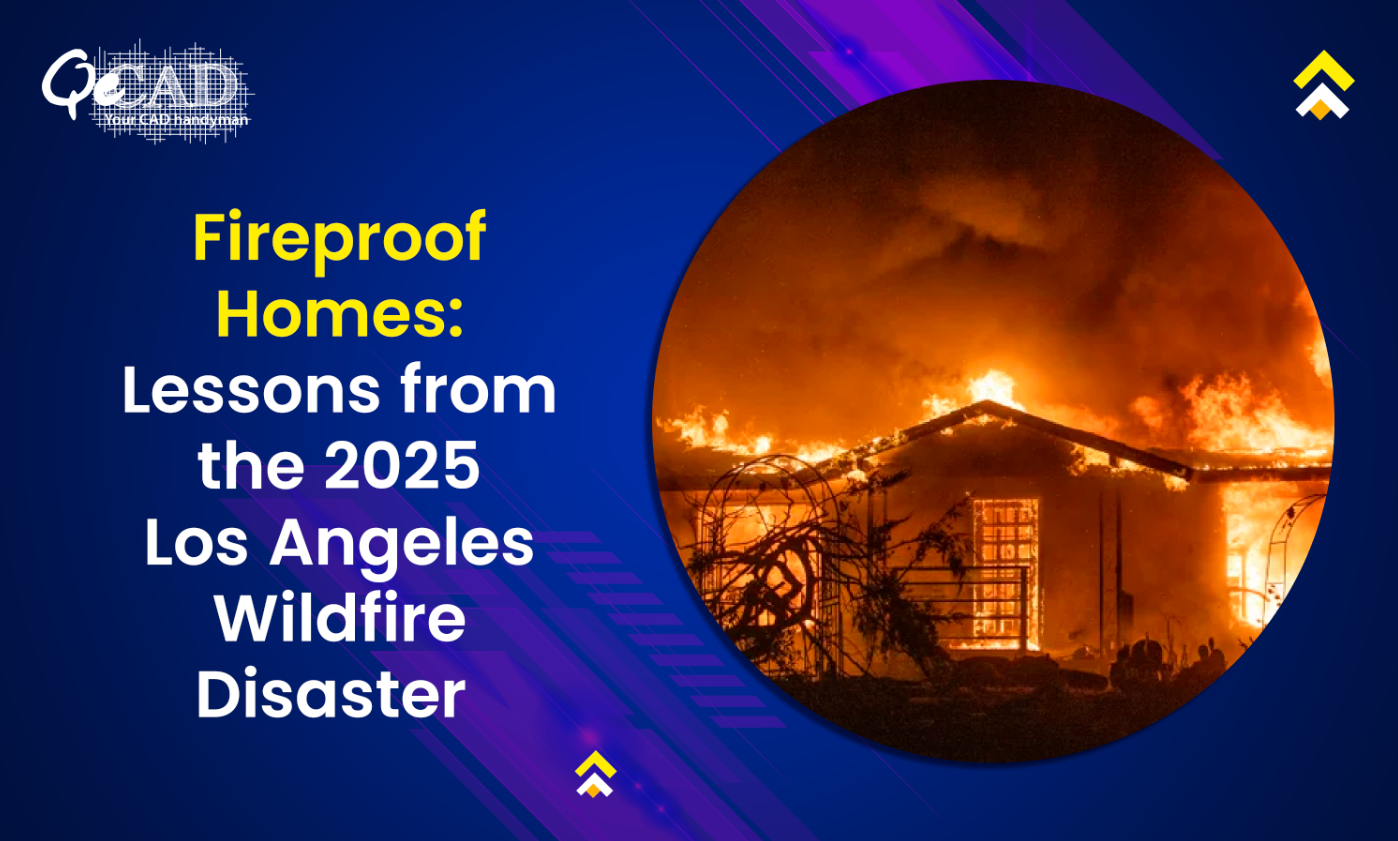
Introduction
The devastating 2025 Los Angeles wildfires once again underscored the critical need for fire-resistant home construction. With over 18,000 structures destroyed, 29 lives lost and an economic toll estimated at $135–150 billion, the disaster serves as a wake-up call for homeowners, builders and policymakers.
As climate change fuels the increasing frequency and intensity of wildfires, adopting the fire-resistant building techniques has become imperative. Additionally, integrating the MEPF Modeling Services in the fireproof home design enhances safety by ensuring the efficient mechanical, electrical, plumbing and fire protection systems.
Understanding the Threat: How Wildfires Destroy Homes
Wildfires spread rapidly due to the dry vegetation, strong winds and embers carried over to the long distances. Homes ignite through three primary mechanisms:
- Ember Attack: Small burning particles travel up to a mile ahead of a fire, landing on roofs, vents and dry landscaping.
- Radiant Heat: Intense heat from nearby flames can ignite combustible materials without direct flame contact.
- Direct Flame Exposure: Structures close to each other or vegetation can catch fire from direct contact with flames.
Understanding these threats is crucial in designing homes that resist ignition and minimizes the fire damage to a greater extent.
Understanding Wildfire-Resistant Construction
Fire-resistant construction involves using materials and design strategies that minimizes the risk of ignition as well as the fire spread. Key strategies includes:
- Fire-Resistant Building Materials
- Roofing: The roof is the most vulnerable part of a house. Class A fire-rated materials such as metal, clay tiles or asphalt shingles offer superior fire resistance.
- Siding: Fiber-cement, stucco and metal sidings reduces the likelihood of ignition compared to wood or vinyl.
- Windows: Double-pane, tempered glass windows prevents the heat from shattering glass and allowing embers inside.
- Decking and Fencing: Composite, fire-resistant wood alternatives reduces the fire risks.
- Defensible Space and Landscaping
Creating a defensible space around homes helps to slow the fire spread. California law mandates a 100-foot clearance around homes in wildfire-prone areas. Key measures includes:
- Removing dead vegetation and dry leaves.
- Maintaining at least 5 feet of non-combustible material around the home.
- Using fire-resistant plants and avoiding flammable mulch near the structures.
- Ember-Resistant Vents and Sealed Openings
Wind-driven embers can enter homes through vents thereby leading to the ignition. For this, the homeowners should:
- Use metal mesh (1/8-inch or finer) to cover attic and crawl space vents.
- Seal gaps around doors, windows and eaves to prevent ember intrusion.
Smart Fireproof Home Technologies to Minimize Risk
Advancements in fire-resistant technology have improved home safety in the wildfire-prone areas. Some innovative solutions includes:
- Fire-Resistant Sprinkler Systems: Automated exterior sprinklers can dampen the roofs and surrounding areas when a fire is detected.
- Fireproof Roofing and Walls: Advanced coatings and fire-retardant treatments on the building materials enhances the fire resistance.
- Smart Smoke and Heat Sensors: These systems can detect embers as well as the rising temperatures hence triggering early alerts and protective measures.
- Ember-Resistant Ventilation Systems: Smart vents close automatically when the embers are detected thereby preventing the entry.
- Fire-Resistant Window Films: Heat-resistant films on windows can reduce glass breakage due to the radiant heat exposure.
Case Studies: Overcoming Fire Disasters
Case Study 1: Paradise, California (2018) – A Lesson in Rebuilding with Fire-Resistant Homes
The 2018 Camp Fire devastated the town of Paradise, California, destroying over 18,000 structures. Following the disaster, rebuilding efforts focused on fire-resistant materials and design strategies. The new homes incorporated:
- Class A fire-rated roofing materials to prevent the ember ignition.
- Defensible space landscaping to reduce the fire spread.
- Concrete-based siding and fire-resistant windows to withstand the heat exposure.
As a result, the homes built to these standards proved more resilient during the subsequent wildfire incidents thereby setting a precedent for the fireproof construction.
Case Study 2: Boulder, Colorado (2021) – Community-Based Fire Mitigation
The 2021 Marshall Fire in Boulder County destroyed over 1,000 homes. However, some neighbourhoods fared significantly better due to pre-emptive community-wide fire mitigation efforts. Key actions included:
- Enforcing strict defensible space laws ensuring properties maintained a firebreak.
- Installing fire-resistant fencing and decks preventing fire from spreading between structures.
- Implementing fireproofing measures for older homes including ember-resistant vents and upgraded roofing.
These proactive measures showcased the effectiveness of collective fire mitigation, emphasizing the need for both individual and community-driven fireproofing strategies.
Lessons from the 2025 Wildfire Disaster
- Code Compliance Saves Lives and Properties
Structures built to the California’s Wildland-Urban Interface (WUI) building codes fared better. Chapter 7A of the California Building Code mandates the fire-resistant materials as well as the construction techniques.
- Retrofitting Older Homes is Crucial
Many of the destroyed homes were older and lacked fire-resistant upgrades. Retrofitting the homes with non-combustible roofing, ember-resistant vents and fireproof siding significantly enhances the safety.
- Community-Based Fire Protection Works
Neighbourhoods that collectively implemented the fire mitigation strategies saw lower destruction rates. Community-wide defensible space initiatives and fire-resistant landscaping were proved effective.
National and International Fire Safety Standards
There are several standards that guides the fire-resistant construction worldwide:
- NFPA 1144: Standard for Reducing the Structure Ignition Hazards from Wildland Fire
- NFPA 703: Fire-Retardant-Treated Wood and Fire-Retardant Coatings
- California Fire Code (CFC): Outlines the fire safety regulations in wildfire-prone areas
- International Wildland-Urban Interface Code (IWUIC): Provides fire safety guidelines for at-risk regions globally
Conclusion
The 2025 Los Angeles wildfire disaster reinforced the necessity of proactive fireproofing strategies. By incorporating the fire-resistant materials, adhering to the building codes as well as maintaining the defensible space, the homeowners can significantly reduce the risks of the wildfire destruction.
As the wildfires are an ever-growing threat, embracing the resilient construction techniques is no longer optional but is essential for the survival and sustainability.
Additionally, integrating the MEP Drawing Services in fire-resistant home construction ensures the optimal design and implementation of mechanical, electrical as well as the plumbing systems thereby enhancing the fire safety and overall resilience.
